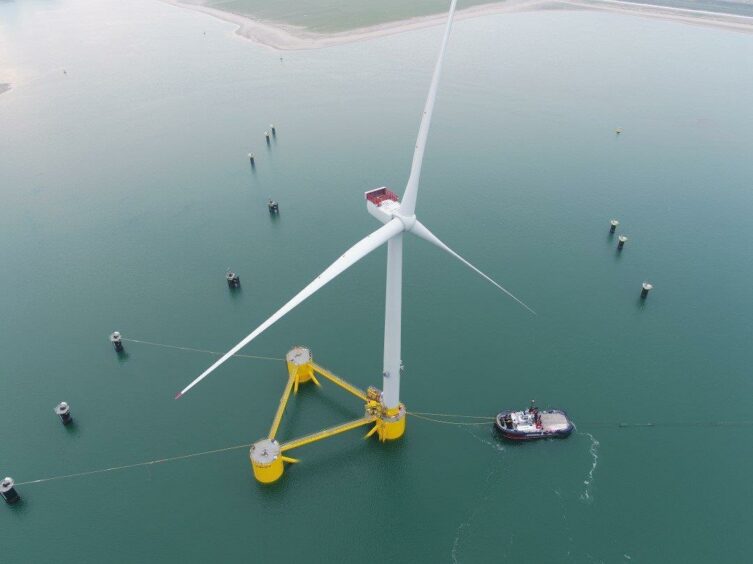
Floating offshore wind (FOW) is the new great hope, the next big breakthrough, in renewable energy. It is a huge worldwide growth area with transformative potential for our people, our communities, and our national wealth and wellbeing.
Right now, Scotland and the UK are vying with countries worldwide to secure a global leadership position in commercial floating offshore wind (FOW) which would confer enormous economic and environmental benefits: energy security; affordable electricity; meeting our net zero ambitions; supply chain sustainability; and – of paramount importance – the development of a skilled, green energy workforce.
The UK is a real contender in FOW. We have already created the world’s most active offshore wind market and installed the most capacity globally. The Scottish North Sea is already home to the world’s first commercial floating wind farm – the 30MW Hywind Scotland – and the world’s largest floating offshore windfarm, the 50MW Kincardine windfarm.
But past performance is no guarantee of future results, as every investor will assure you. It’s also the case that our local manufacturing supply chain was more of a bystander than a participant in the fixed offshore wind boom. Now we must combine this with a truly world-class subsea industry that has the requisite skills, technology and track record to keep us ahead of the pack.
We have the chance to raise our game with FOW and to become a serious player, as it’s currently a much less developed market than fixed offshore wind. It also plays to many of our existing oil industry supply chain strengths which are directly transferable however it requires major infrastructure investment and support for steel fabrication and welding processes portside to meet serial volumes.
Ensuring that we have the right combination of people, skills and facilities in place is fundamentally important if we are to capitalise on this fantastic opportunity. This will require a cross-industry view and a coordinated, collaborative approach with UK and Scottish Government if we are to work smartly at scale and pace to realise and optimise our design, build and installation capability.
For this reason, OPITO and the PowerHouse recently held an international industry-wide workshop consultation with some 100 key stakeholders, all with a keen interest in the successful development of UK FOW.
Our own organisation, OPITO, is a global skills body for the worldwide offshore energy industry so we have skin in the game when it comes to exploring the future skills requirement in FOW.
Our co-host, the PowerHouse, is a new applied research centre based in the Cromarty Firth, a serious ‘Green Free Port’ contender at the very heart of Scotland’s renewable energy industry. Part of the University of the Highlands and Islands (UHI), a core part of its remit is developing the workforce skills needed for floating offshore wind and accelerating its development.
In the spirit of collaboration, and using the principle of the wisdom of crowds, we put five key questions on FOW skills to our vast panel of international experts and captured their invaluable insights. We were keen to penetrate below the grand strategy level to get to the very granular issues that will affect the UK and Scotland’s day-to-day viability and competitiveness in the sector. Their views are shared below.
What was indisputable was the enthusiasm and excitement about the possibilities, tempered by a realism that, together, we need to get this right.
UK offshore wind is entering a goldrush phase with a potential investment of some £155 billion forecast across development, manufacturing, and operations between now and 2030.
That in turn will see the total workforce swell to almost 100,000 over the same period, if projects such as Round 4 and the recent Scotwind Leasing Round awards are delivered on schedule.
So, on current projections and with investment and development at scale and pace, floating wind will be competitive with other energy forms by 2030.
Looking still further ahead, UK floating wind could be generating 33GW of energy by 2040. At that stage, the FOW workforce would number 67,000, independently from fixed offshore wind.
It is entirely feasible that Scotland and the UK could be designing, manufacturing, building and operating the next generation of 15+MW turbines, as long as we can scale competitively, source sufficient supplies of green steel and develop our existing deep water port infrastructure.
That all sounds very positive but, above all, we must ensure that we have a skilled and productive workforce in place to realise this ambition. This is the view from our experts on the key questions that will determine whether we emerge as champions or also-rans.
1. What are the differences in skills required for working in the floating vs. fixed offshore wind industry?
There are many transferable skills but some major differences. It’s vital that a proper gap analysis is undertaken so that we can predict and prepare with certainty rather than just making assumptions.
But we do know that the skills and jobs profile of FOW is distinct from the fixed wind with a substantially greater number of workers in the field as opposed to the office. FOW requires much more in the way of marine and subsea skills such as towing, anchoring, and mooring systems expertise.
Blue collar trade skills will be in high demand including construction, welders, platters, electricians, riggers, scaffolders. Subsea skills – such as ROV pilots and technicians and surveyors – will be at a premium. Marine crew from captains and towing masters to marine engineers and crane operators will also be critical to unlocking the potential of FOW.
2. What is the timing of provisions/the anticipated number of roles required in each stage of development?
The consensus is that the Highlands needs to invest in business infrastructure as there is an unmet requirement for business units. Finding accommodation for employees in rural areas has been a problem for organisations that are recruiting for renewables. It is a struggle to attract skilled workers to an area where there is nowhere for them to live.
Given the strategic scale, project lead times are several years so meeting the 2030 target will require executions and advanced manufacturing and construction skills in place by 2025. If collaboration on consenting and environmental impacts can be achieved, then more projects are likely to be able to move forward at a similar rate.
Industry apprenticeships need to start now as their skills will be needed in the second half of the decade. There also needs to be a strong STEM focus in the school education curriculum and encouragement for young people to seek careers in this field to ensure a sustainable workforce.
3. What are the skills required for an oil and gas worker and/or nuclear industry worker transitioning into the floating offshore wind industry?
Many of the skills are directly transferrable but workers from the hydrocarbon and nuclear sectors must expect to adapt to different ways of working in terms of agility, culture, pay and conditions. Looking to other energy sectors, and beyond, for skills is valid but we must be aware that poaching talent from other sectors is a zero-sum game for the economy.
Given that much of the training in floating offshore wind takes place on the job, previous experience of working in the offshore environment is highly desirable and transferrable. However, the development of new and bespoke FOW training courses is needed.
One issue for FOW is that Scottish net zero industries can’t compete as attractive employers with nuclear projects or current pay and conditions in the oil and gas sector. Investment in competitive pay rates, to avoid losing skills to other sectors or territories, will be important.
4. What are the current gaps and shortages in skills/qualifications for floating offshore wind?
The shortage of skills in large-scale project and programme management is a problem, especially for those projects where integration across many areas is required. Consenting is also likely to be a real bottleneck and could have a huge knock-on effect in terms of timescales.
Demand for fabrication and welding skills is likely to outstrip supply. The same is true of concrete pourers, depending on whether steel or concrete predominates. There will also be high demand for electrical, high voltage and control room engineers. ROV pilots are already in demand and that will intensify.
Geoscience requirements will grow significantly with increasing vacancies for geologists, geophysicists, and geotechnical engineers.
5. What is the percentage of practical vs. theoretical training required?
This question produced a classic bell curve in terms of responses. Some responders ventured that the practical component was either 40% or 80%. However, the consensus was that the optimum balance in training was around two-thirds practical to one-third theoretical. Good hands-on skills and practical experience were seen as more valuable than academic knowledge, although both are necessary.
Final thoughts
As an industry, we are all committed to ensuring that people across the region and the nation have the skills and experience to take advantage of the nationally important FOW projects that are being developed.
There is a huge amount of hard-earned competency and a high degree of skills transferability, in the oil and gas industry that will serve the floating offshore wind industry well. But it’s up to all of us, collaboratively, to get these incredible opportunities off the drawing board and out into the supply chain whilst ensuring that communities and the workforce are not left behind.
Recommended for you

 © Supplied by OPITO
© Supplied by OPITO